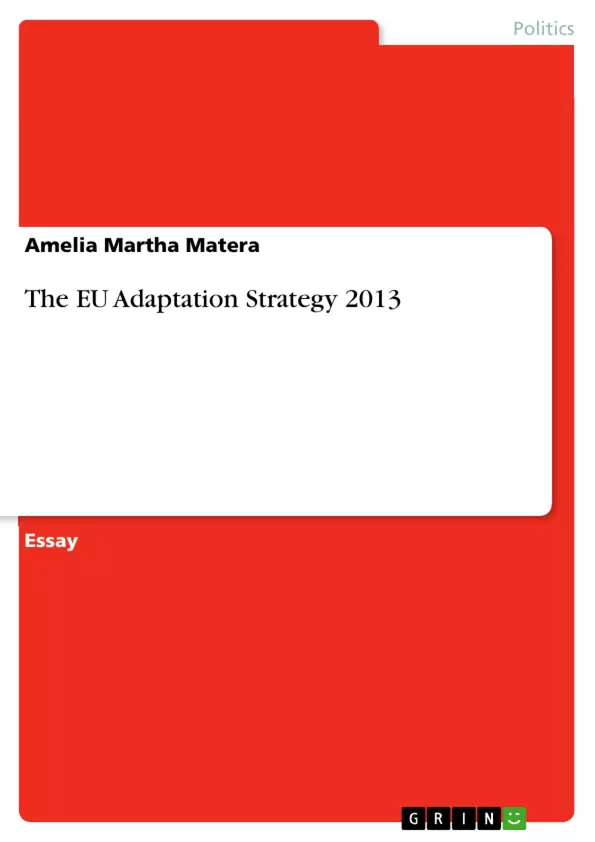Climate policy for the European Union (EU) was irrelevant until the 70s, it became a topic on the political agenda only in the 80s, and today its policy includes adaptation.
The European Union recognises that some of the impacts of climate change caused by past emissions are irreversible. The policy responses of climate change are adaptation and mitigation.
The main reason for a weak adaptation strategy in mid 80s and 90s was the reluctance of the Member States (MS) to give up power to the supranational institutions. But it was only when the IPCC report put emphasis on adaptation arguing that it should concern even industrialized countries and not only Developing countries (DC) that things started to change. The EU has adopted in 2013 the Adaptation Strategy, which has been strengthened since the 5th National Communication.
The aim of this paper is to critically assess EU’s current trends in adaptation actions, as well as future adaptation requirements. In order to reach this goal this paper will rely on two main documents: sixth EU’s National Communication to the UNFCCC and to the correspondent UNFCCC’s in-depth review.
The first part will give a brief overview of the EU adaptation strategy, its development and the main official documents, the second part is a more detailed analysis and criticism on the actions described in the current EU adaptation strategy. Before the conclusion, the main criticism will be highlighted and the future adaptation requirement outlined.
Inhaltsverzeichnis (Table of Contents)
- Introduction
- Development of EU Adaptation Strategy
- EU Adaptation Strategy 2013
- Critical overview
- Future adaptation requirements and conclusion
- Bibliography
Zielsetzung und Themenschwerpunkte (Objectives and Key Themes)
This paper critically assesses the current trends in adaptation actions taken by the European Union (EU) and outlines future adaptation requirements. It draws primarily on the sixth EU's National Communication to the UNFCCC and the corresponding UNFCCC's in-depth review. The paper examines the development and main documents of the EU adaptation strategy, provides a detailed analysis of the actions described in the current strategy, and highlights the key criticisms while outlining future adaptation needs.
- Development and main documents of the EU adaptation strategy
- Critical analysis of actions described in the current strategy
- Key criticisms of the EU adaptation strategy
- Future adaptation needs of the EU
- The role of the UNFCCC in shaping EU adaptation policies
Zusammenfassung der Kapitel (Chapter Summaries)
- Introduction: This chapter introduces the EU's climate policy, its evolution from irrelevance in the 70s to the inclusion of adaptation today. It discusses the policy responses to climate change, specifically adaptation and mitigation. It highlights the challenges in developing a strong adaptation strategy in the 80s and 90s due to Member State (MS) reluctance to cede power to supranational institutions. It also discusses the shift in perspective with the IPCC's emphasis on adaptation and the subsequent adoption of the EU Adaptation Strategy in 2013.
- Development of EU Adaptation Strategy: This chapter defines adaptation, highlighting its different forms and the distinction between spontaneous and planned adaptation. It explores the concept of resilience and its relationship to adaptation. It examines the implementation of adaptation strategies in different levels of European governance and presents examples of adaptation measures in specific fields. The chapter also outlines the future risks of climate change for Europe as identified by the IPCC, including economic losses, flooding, and water availability challenges.
- EU Adaptation Strategy 2013: This chapter delves into the EU adaptation strategy initiated in 2013, which focuses on promoting action by Member States, ensuring better-informed decision-making, and addressing key vulnerable sectors. It analyzes the actions implemented under this strategy and highlights the discrepancies in the implementation of National Adaptation Plans (NAPs) and National Adaptation Strategies (NASs) across Member States. It discusses the financial resources available through the LIFE fund and the challenges in ensuring clear oversight and accountability. The chapter also examines the Covenant of Mayors for Climate and Energy, its aims and limitations, and its role in supporting urban adaptation efforts.
Schlüsselwörter (Keywords)
The main keywords and focus topics of this paper are: EU adaptation strategy, climate change, mitigation, adaptation, UNFCCC, National Communication, in-depth review, Member States, adaptation actions, future adaptation requirements, resilience, vulnerable sectors, LIFE fund, Covenant of Mayors, urban adaptation, climate-resilient Europe.
- Quote paper
- Amelia Martha Matera (Author), 2018, The EU Adaptation Strategy 2013, Munich, GRIN Verlag, https://www.grin.com/document/442595



